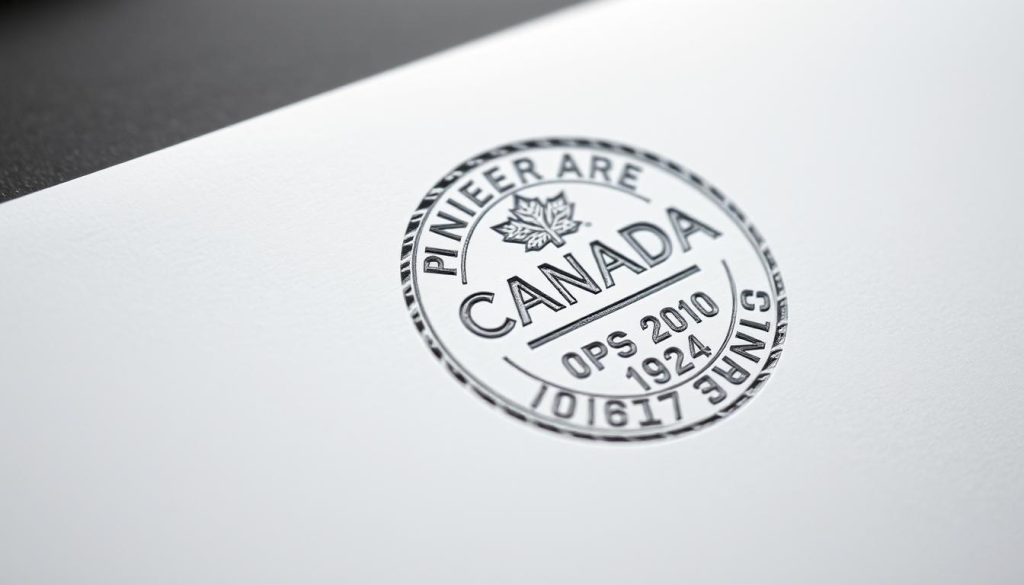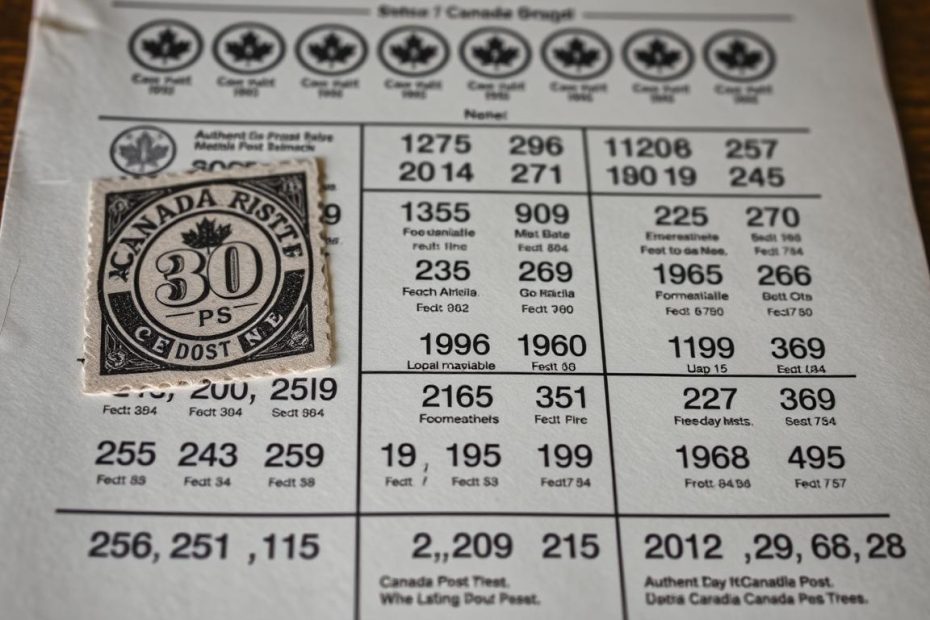Ever wondered what those ink stamps on your mail mean? Canada Post postmarks are more than just marks. They tell you when and where your letter went.
It’s not just for postal workers or stamp collectors. Anyone can learn to read these stamps. It helps track shipments and understand mail routes. This guide will show you the secrets of these stamps.
Postmarks tell the story of your mail’s journey. They share important info beyond just dates and places.
Key Takeaways
- Postmarks provide essential tracking information for mail
- Understanding postmark codes helps track postal routes
- Each postmark contains unique geographic and temporal data
- Canada Post uses standardized marking systems
- Postmark reading is a valuable skill for shipping professionals
Understanding Canada Post Postmarks
When you get mail, the stamp tells a story. Canada Post uses these stamps to track your mail. They show when and where your mail was sent.
Postmarks do many important things. They prove when and where your mail was handled.
What is a Postmark?
A postmark is a special mark on your mail. It includes:
- Date of mail processing
- Location of postal facility
- Cancellation information for postage stamps
Purpose of Postmarking
Postmarks have a few main jobs. They:
- Stop people from using stamps twice
- Help track when your mail was sent
- Show when your mail was mailed
These stamps are key for urgent or legal mail. They prove when a letter was sent.
| Postmark Element | Purpose |
|---|---|
| Date | Confirms mail processing time |
| Location | Indicates postal facility origin |
| Cancellation Mark | Invalidates postage stamp |
Knowing about postmarks helps you track your mail better. It shows how the postal system connects Canada.
Key Elements of a Postmark
Decoding a postmark is like unlocking a secret message from Canada Post. It’s the first step in tracking your mail. Every postmark has important details that show where your mail has been.
Postmarks are not just ink stamps. They are a way for postal workers and customers to track mail. Let’s look at the main parts you’ll see:
Deciphering Date Codes
Date codes are the heart of tracking mail. They usually have:
- Day of the month
- Month abbreviation
- Year (often in two-digit format)
- Time of postmark (sometimes included)
Location Indicators
Location indicators show where your mail started. A postal code lookup can tell you a lot about the sending place. These indicators often include:
- City name
- Provincial abbreviation
- Unique postal facility code
Additional Markings
Postmarks can also have special symbols or notes. These give extra information about how your mail was handled.
By learning about these parts, you can read and understand Canada Post postmarks better. This will improve your skills in tracking mail.
How to Interpret the Date Code
Understanding postmark date codes is key for tracking mail. Canada Post uses special codes to share mail details.
Looking at a postmark, you’ll see important parts. These codes tell us about the mail’s journey.
Decoding the Date Format
Canada Post uses a standard date format. It has:
- Year shown by last two digits
- Month by a number
- Day of the month
Practical Examples of Date Codes
Let’s look at a typical postmark date code:
| Code Section | Meaning | Example |
|---|---|---|
| First Two Digits | Year | 23 = 2023 |
| Next Two Digits | Month | 04 = April |
| Last Two Digits | Day | 15 = 15th day |
Postal workers use these codes to track mail. Observing them closely can show interesting mail journey details.
Handling Variations
Not all postmarks look the same. Some might have:
- Time of processing
- Postal facility code
- Special handling signs
Learning these date code meanings helps track mail better.
Understanding Postal History
Postal history is really interesting. It shows how communication has changed over time. Canada Post has grown a lot, giving us lots of history to explore.

Postmarks are more than just stamps. They are like time capsules that tell us about mail’s journey. Each mark has its own story about how letters moved.
The Collector’s Treasure
Stamp collectors love postmarks. They are like treasures that tell us a lot. They show us:
- Mail routing patterns
- Geographical postal locations
- Specific dates of transmission
- Postal service operational details
Historical Narrative of Canadian Mail
Postmarks show how Canada’s mail system has changed. From old stamps to new digital ways, they show how technology has grown.
Collectors see postmarks as historical artifacts. They help us understand Canada’s mail network. They tell us about different places, how people moved, and old communication ways.
Common Postmark Symbols and Their Meanings
Learning about Canada Post postmarks is fun for mail lovers and collectors. You’ll find many symbols that tell you about your mail’s trip.
Canada Post uses special symbols to share important info about your mail. Knowing these symbols helps you track your packages and understand the postal system.
Decoding Postmark Designs
Postmarks have key parts that share useful info:
- Date of mailing
- Postal location
- Processing facility code
- Special handling indicators
Common Postmark Symbols Explained
Each symbol on postmarks means something different:
| Symbol | Meaning | Importance |
|---|---|---|
| Circular Cancel | Standard cancellation mark | Indicates mail has been processed |
| Priority Mail Indicator | Expedited shipping | Signals faster processing |
| Registered Mail Symbol | Tracked and insured | Provides additional security |
When you look at a postmark, find these special signs. They tell you about your mail’s journey in Canada.
Tips for Collecting Postmarked Items
Collecting postmarked mail is fun. It lets you learn about postal history. Knowing about mail delivery and stamps makes collecting better.
Looking for special postmarked items takes skill. Here are tips to help you:
Where to Find Postmarked Mail
- Antique stores and vintage shops
- Online auction websites
- Philatelic societies and stamp clubs
- Estate sales and flea markets
- Canada Post historical archives
Best Practices for Preservation
Keeping your mail safe is important. You need to keep it looking good and intact.
- Use acid-free archival sleeves
- Store in cool, dry places
- Handle with clean, white cotton gloves
- Avoid direct sunlight
- Keep records of each item’s history
| Preservation Method | Benefits |
|---|---|
| Archival Sleeves | Prevents physical damage |
| Climate Control | Prevents deterioration |
| Careful Handling | Maintains item’s original condition |
Your collection is like living history. Each stamp has a story about mail and old times.
Troubleshooting Common Issues
Figuring out postmarks can be tricky. Sometimes, canadian mail tracking gets hard when postmarks are unclear or damaged. Knowing how to deal with these problems can save you time and make your research easier.
- Use a magnifying glass to look closely at faint marks
- Check the postmark from different angles for clearer details
- Compare it with other postal code lookup examples
- Take a photo of the postmark to enhance it digitally
Identifying Ambiguous Postmarks
Ambiguous postmarks can happen for many reasons like smudged ink, partial stamps, or old postal machines. Digital tools and high-resolution images can show details that are hard to see by eye.
When to Seek Expert Help
Even with careful looking, some postmarks might not show all their info. Experts in philately and postal history can offer special help when you hit a wall.
- Look up postal history groups
- Ask professional stamp collectors for advice
- Join online forums about postal markings
Remember, being patient and careful is key when solving hard postmark problems.
Advantages of Understanding Postmarks
Exploring postmarks is like opening a door to a world full of history and stamps. It’s not just about tracking mail. It’s about finding stories in postal marks.

- Get better at tracking mail
- Learn more about postal history
- Find special stories in postal items
Elevating Philately Skills
Learning about postmarks makes your stamp collecting better. You’ll get skills like:
- Checking if old mail is real
- Finding out when mail was sent
- Spotting rare mail marks
Connecting with Canadian Historical Context
Postmarks are like tiny history books. They show where and when Canada’s mail service changed.
| Skill Developed | Historical Insight Gained |
|---|---|
| Postmark Date Interpretation | How postal services grew in different places |
| Location Code Recognition | Where people moved to |
| Cancellation Mark Analysis | How mail technology changed |
By learning about postmarks, you become a true postal historian.
Conclusion: Embracing the World of Postmarks
Learning about Canada Post postmarks is more than just reading stamps. It connects us to a deep history of communication. Canada Post helps us see how mail moves quickly and efficiently.
In this guide, you learned how to read postmarks like a pro. You can now spot date codes and special postal symbols. This knowledge lets you see mail as more than just letters.
Key Insights Recap
Every postmark has its own story. Whether you collect stamps or just like history, these marks are full of interesting facts. They show us Canada’s postal history in a new way.
Your Next Steps
Start looking at your mail differently. Find the small details in postmarks and track where your mail goes. Join groups or online forums to share what you find and learn from others.
